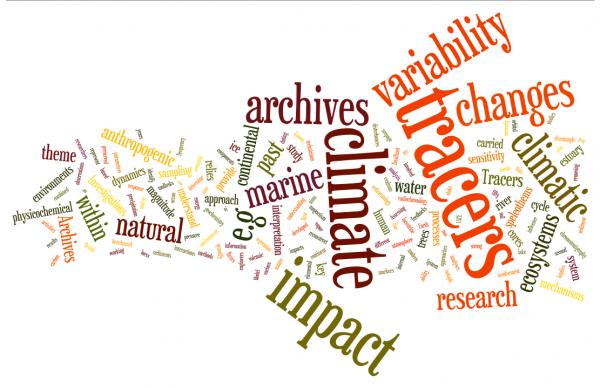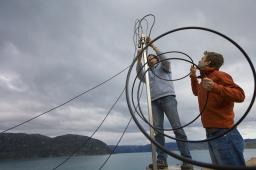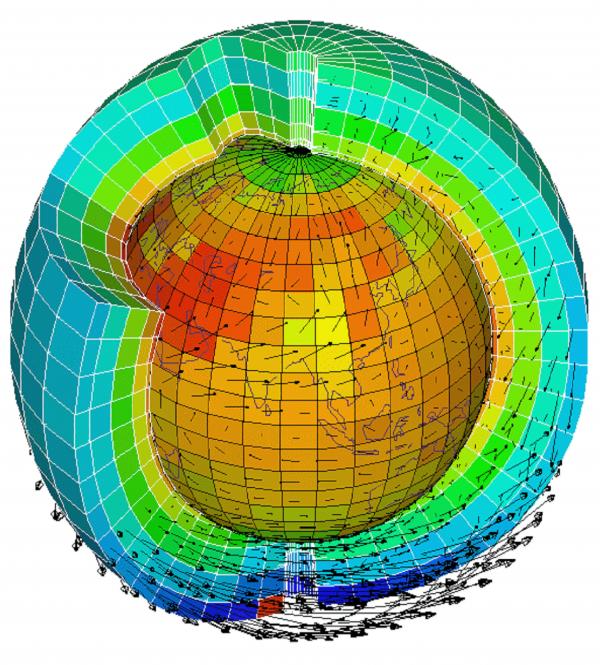The aim of work carried out by the "Archives & Tracers" group is to understand the dynamics and the natural variability of climate and to evaluate the sensitivity of marine and continental environments to climatic and anthropogenic changes.
To understand the natural variability of climate, knowing the magnitude and frequency of past changes is a key step. To look back at the past makes it possible to get away from human disturbance. In these conditions, reconstruct past changes helps us to understand the functioning of the complex climate system and to identify and quantify interactions and fluxes between the different climatic system components: atmosphere, ocean, ice and continent. Study of past climate changes and of their impact on ecosystems tells us how the climate system responds to known perturbations (orbital and volcanic). For fifty years, LSCE has developped methods for reconstructing climatic parameters from the analysis of physico-chemical markers in natural archives (ice-core, marine and lake sediments, loess, speleothem, tree, coral, mollusc …). Such data provides a benchmark to test the ability of Earth System Model to correctly represent these mechanisms, the magnitude and dynamics of past changes.
The evaluation of the sensitivity of marine and continental ecosystems to climatic and anthropogenic changes relies on two approaches. The first, in line with previous approach is based on the study of natural climate archives that informs of past impacts of climate change on various ecosystems. The second is based on the study of present ecosystems under the combined climate and human pressures (river, soil, marine environment, water cycle, …).
This research is based on the investment of all group members from the sampling to results interpretation: i- sampling (ice-core, marine, lacustrine and fluvial sediment cores, …), ii- physico-chemical analyses including isotope geochemistry, magnetism, micropaleontology, sedimentology, …, iii- dating through both chronostratigraphy and radiochronology, iv- tracer meaning (climate and/or anthropogenic signal record, signal preservation and fossilization).
The group includes five complementary research teams and group located in CEA Saclay: CLIMAG (Climate, Paleomagnetism), GEOTRAC (GEOchronology, TRacers and ArCheometry), GLACCIOS (Ice and Continent, climate and stable isotopes), PALEOCEAN (Paleoceanography), OCEANIS (Ocean and Interfaces).
The Biogeochemical Cycles and Transfers to the Environment Theme involves ca. 110 researchers, engineers and technicians (including 45 permanent staff) in seven research teams with the aim of characterizing and quantifying biogeochemical cycles of greenhouse gases (GHG) and mass transfers inside and between environmental compartments. The purpose of these studies is to better understand and predict the evolution of these cycles related to climate change or environmental change impacts, from the global to the local scale (city, watershed). The Theme's research is based on an original continuum from observations to modeling. They involve systematic observation capabilities, including the European research infrastructure ICOS (Integrated Carbon Observing System), experimental sampling and analysis, and numerical simulation tools.
The first important part of the study of biogeochemical cycles is based on an atmospheric approach. For the main long-lived GHG of human origin (CO2, CH4, N2O), a better understanding and a more precise quantification of fluxes must be based on a very high precision observatories network, as the signals related to the fluxes under investigation are very low relative to the background concentrations.
The Theme has a strong recognition at global level in GHG metrology through its Atmospheric Thematic Center (ICOS-ATC) of the European ICOS research infrastructure, including a data center and a metrology laboratory.
The ICOS-RAMCES team ensures France’s contribution to the European in situ GHG measurement network, with 16 stations in France and around the world to better characterize the atmospheric distribution of GHGs and improve the methodologies for observing and estimating surface fluxes at various scales based on its atmospheric measurements .
The SATINV team develops and implements so-called inversion approaches to quantify sources and sinks of the three main GHG leading to the mapping of surface fluxes from these atmospheric measurements, in particular for the European Copernicus Atmosphere service. In addition, in-house expertise in space-borne measurement of GHG is used to exploit data and prepare future missions, notably the French-German MERLIN (CH4) and French MicroCarb (CO2) missions. Atmospheric chemistry is also studied (CAE team) through aerosols and short-lived reactive gases, based on regional and local atmospheric measurements, from the unpolluted sub-Antarctic atmosphere to the Paris region characterized by air pollution with complex origins. This activity contributes to the ACTRIS research infrastructure.
The second part focuses on a better understanding of material exchanges and lateral transfers on continental surfaces. The MOSAIC team is working on the modeling of the continental biosphere and exchanges at the surface-atmosphere interface in order to better understand the key material balance processes, with expertise on data assimilation and fusion and a tool key, the ORCHIDEE model. The GEDI team is interested in the influence of anthropogenic activities on the transfer of matter (particles, carbon and contaminants associated with particles) on continental surfaces and in the ocean using geochemical tools (stable isotopic tracers and radioactive, elementary tracers), from the local scale to the major river basins. The HYDRO team aims to model the functioning of continental hydrosystems (underground aquifers, lakes, rivers, etc.) and in particular their response to weather or climate forcing.
Numerical simulation (modelling) is a major specialty of the LSCE since it was created. Initially, modelling approach was conducted by paleoclimatologists (thematic: Arcives and tracers), who investigate relatively long periods of time (from hundred to several hundred of millions years), and also by biogeochemists (thematic Biogeochemical cycles et Transfers in the Environment) dealing with shorter timescales. Since 2010, climate modellers are gathered in a single thematic group. They work on interactions between climate and cycles, and investigate various periods of time. Modelling researches are closely connected to observations activities conducted at the LSCE, for reconstructing past climates, as well as for monitoring atmospheric composition and fluxes between the atmosphere and land and ocean surfaces.
The different teams of this research activity are located at the LSCE-Orme des Merisiers. They focus on the climate variability and the interactions between the different components of the Earth system (MERMAID), on the climate dynamics at various timescales (CLIM), on the model computing infrasctuctures (CALCULS), and on the statistical methods for studying the variability of the climate and downcaling techniques (ESTIMR).









